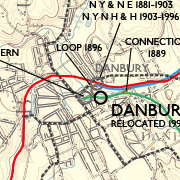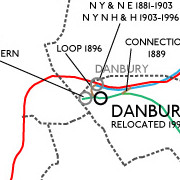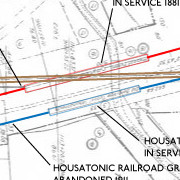Historical Sketch
Railways were proposed in the Danbury area in the 1830s, the decade
when advances in civil engineering and steam locomotive design made
railways practical. Bridgeport businessmen promoted the Housatonic
Railroad, which would run near but not through Danbury, and others
promoted the Danbury and Norwalk Railroad. Danbury by this time was an
important inland market town with a popular annual fair.
The Housatonic Railroad was the first local railway to open.
It ran generally north from rail and water connections at Bridgeport
to northwest Connecticut and eventually to Pittsfield MA. The first
section to be completed opened in 1840 up to New Milford. It included
a rock tunnel in Newtown often called the Hawleyville Tunnel. The
original goal of the railway was to reach quarries, iron mines and
foundries, potteries, and other industries in northwest
Connecticut. Later it became an important passenger route to the
Berkshires.
The Danbury and Norwalk Railroad had been proposed around the
same time as the Housatonic, but financing and construction was much
delayed. It opened in 1852 between its namesake cities. The Danbury
terminal was at Main Street.
Both the Housatonic and the Danbury and Norwalk depended on the New
York, New Haven and Hartford Railroad at Bridgeport and Norwalk for
rail connections to other points, and the New Haven Railroad's
management made the most of their monopoly. The Housatonic did have a
dock for water connections as an alternative, and the D&N
eventually built a dock at Norwalk too.
In the later 1860s two new railroad projects were proposed in the
area. The New York, Housatonic and Northern Railroad was
intended to provide the Housatonic Railroad with an alternate rail
route to New York. The first section constructed was the only one
opened, from Brookfield Junction on the Housatonic to Danbury, in late
1868. This much of the line was useful in its own right.
For a few months the NYH&N ran into the D&N's Main
Street station in Danbury, but in 1869 the company built a separate
station a few blocks away at White Street, and removed the track
connection to the D&N. From White Street station the line was
intended to continue around the west side of Danbury to the Fair
Grounds, and then southwest through Ridgebury and North Salem, and on
to White Plains and Mount Vernon. Along this route the company
acquired and graded 23 miles of line that was never used. The company
was foreclosed in 1875 and all the unfinished line was sold off.
Local historians and railfans report that some of the grade is still
visible.
The Housatonic began operating the Danbury section of the NYH&N in
1872, and later purchased it. This began a period of competition for
Danbury freight traffic. For passengers going south the D&N's
route via Norwalk was shorter and faster than the Housatonic.
The second proposed line of the 1860s was the Ridgefield and New
York Railroad. Like the NYH&N the company purchased and graded
many miles of its route from Ridgefield to East Port Chester (in
Greenwich), but none of the R&N's line ever opened.
The Danbury and Norwalk hurriedly constructed a branch to Ridgefield
in 1870, in a bid to stop the town from offering financial assistance
to the R&N. The branch began at the former Ridgefield Station,
known ever since by the obvious name Branchville. Passenger service
ran only until 1925, and the whole branch was abandoned in 1964.
Although work stopped in 1873, the R&N was not dead. The company
kept applying for extensions of their time limit through the 1880s and
did not sell off the land. By 1886 it was described as running from
Danbury. The New Haven acquired the property in 1906 and still held it
in 1915 when the company prepared valuation maps (available online at
the University of Connecticut library). The survey route to Danbury is
shown, meeting the New York and New England line at the Fair Grounds
curve, but the property north of Titicus was not owned.
A short line called the Shepaug Railroad opened in 1872 from
Hawleyville station on the Housatonic up to Litchfield over a very
twisty route. The Danbury and Norwalk built a branch from Bethel to
reach it, which was operated by the Shepaug. The D&N link, which
had no stations, was one of the earliest abandonments in Connecticut,
1911. From 1908 the Shepaug's trains ran to Danbury instead, via the
NY&NE route.
The east-west main line at Danbury was proposed as early as 1845, by
the New York and Hartford Railroad, which would have run from the New
York and Harlem at Brewster via Danbury and Waterbury to Hartford.
This route was not built for 35 years. After a series of corporate
reorganizations, the last link was completed by the New York and
New England Railroad in 1881, from Waterbury to Brewster to
Fishkill on the Hudson River.
The NY&NE came the closest of any company to competing with the
New Haven system for traffic between New York and Boston. Oddly
enough, considering the cutthroat competition, the two companies did
run through and connecting services using the NY&NE east of New
Haven or Hartford. The NY&NE west of Waterbury was in a much
weaker position for passenger services, because the curves and grades
and poor connections made through travel on it much slower. For a
short time from 1881 there was an attempt to promote connecting
service at Brewster via the newly opened New York and Northern,
another railroad burdened with curves and grades, later known as the
Putnam Division of the New York Central.
The NY&NE routing in the Danbury area was closely related to
the existing railways. Coming in from the east, at Newtown it came
alongside the Housatonic, running parallel on the north side
through its own tunnel and through Hawleyville. It then crossed
over to the south side of the Housatonic and then diverged to run
toward the former NYH&N line at what was later called Berkshire
Junction.
The NY&NE then ran on the NYH&N grade itself into
Danbury. This was possible because as a Housatonic branch, only one
track had been laid on the two-track grade. Just before entering
Danbury center, the NY&NE crossed to the north side of the
Housatonic and entered another White Street station next to the
Housatonic's station.
From here the NY&NE ran west along the intended route of the
NYH&N as far as the Fair Grounds, possibly using the NYH&N
grade. This was most likely also the intended route of the plans
dating to 1845, and so was the the rest of the NY&NE route west
to Brewster.
At this point, 1881, there were three stations in Danbury, offering
service south from Main Street station on the Danbury and
Norwalk ; north from White Street station on the Housatonic ;
and east and west from the other White Street station on the New York
and New England. But the era of consolidation would soon begin.
The Housatonic acquired the Danbury and Norwalk and the Shepaug in
1886. Three years later the Housatonic built a connecting track at
Danbury so that Brookfield trains could run into Main Street station,
and closed its White Street station. Through trains to New York began
using the Danbury Branch instead of the longer route via
Bridgeport. Some stopped at Danbury Main Street, a stub terminal that
required a reverse move, and some bypassed Danbury using another new
connection at Hawleyville to the ex D&N Shepaug branch. Freight
trains also ran down the Danbury Branch to a dock at Wilson's Point,
Norwalk.
The New York and New England, still trying to create routes avoiding
the New Haven system, ran two unusual services around this time. In
1891 the NY&NE started the Long Island and Eastern States Express,
which came down from Boston on the NY&NE to Hawleyville, over the
Housatonic to Wilson's Point, by carfloat to Oyster Bay, and over the
Long Island Rail Road to Long Island City. But the New Haven acquired
the Housatonic in 1892 and cut off this longer and more expensive
routing. The NY&NE then started an an overnight Pullman train that
ran down to Brewster, stopping at Danbury in the wee hours, and then
over the New York and Northern to the 155th Street terminal in
Manhattan. It took eight hours, not counting the connecting ride on
the Sixth Avenue elevated railway to the main part of the city, and
was dropped in 1893.
The "Consolidated" New Haven system acquired the bankrupt New York and
New England in 1895, completing its acquisition of all the railways in
the area except the New York and Harlem, off to the west in New York
State. The New Haven was known for obsessively purchasing almost every
other railway in its territory of Connecticut, Rhode Island, and
southeastern Massachusetts, even local trolley roads. This probably
accounts for its purchase of the unbuilt Ridgefield and New York in
1906.
One of the very few Connecticut railways not acquired by the
New Haven was the Danbury and Bethel Street Railway. This
company, originally the Danbury and Bethel Horse Railway, operated
horsecars and then electric trolleys from 1887 to 1926. The
north-south route ran from northern Danbury down Main Street and out
to Bethel. The east-west route ran in various streets within Danbury,
with a long branch west to the Fair Grounds and the company's "trolley
park" amusements at Lake Kanosha. All of the trackage was in
streets. Like many trolley companies, its revenues dwindled in the
1920s as more people acquired automobiles, and the rail system was
abandoned in favor of bus services.
Around 1900 there was a boom, akin to the more recent dot-com era, in
which there was much excitement about building interurban trolley
lines between cities. No plan was too foolish to get funding. Some
visionaries formed the Danbury and Harlem Traction company
("traction" was a name for trolley services) to build a route from
Danbury to Goldens Bridge station on the New York and Harlem. It was
imagined to provide a faster route for passengers and freight than
the Danbury Branch.
The D&HT line branched off the Danbury and Bethel Street Railway
near the Fair Grounds and ran through Ridgebury and into New York
State. Most of it did not run in streets. From 1900 to 1901 the
company purchased land, graded the line, laid track and erected wire,
and built a powerhouse. A Danbury and Bethel trolley made a test run,
probably in 1901. And that was all. The New York Times reported
in 1908 that the route was two-thirds built, and the Bridgeport
Herald in 1909 said the track ended "six miles short of Goldens
Bridge", which would be somewhere in North Salem. But the occasion for
both reports was the sale and demise of the company.
The D&HT grade in Ridgefield and part of North Salem is well
defined in aerial photographs taken in 1934 (available online at the
University of Connecticut library). Part of it is now a street
called Old Trolley Road. Local historians and railfans report that
much of the grade is easily seen winter.
The first few miles out of Danbury follow a route very similar to the
New York, Housatonic and Northern graded some thirty years earlier.
It is not clear whether some of the D&HT grade actually is
that grade. South of its few blocks of street running in Ridgebury,
the D&HT takes a sharp turn that seems to bring it back to a
continuation of a smoother curve. The map on this web page is a little
speculative on these two. While two different alignments are shown,
the D&HT is based on the 1934 aerial photographs, and the
NYH&N is based on older maps that are somewhat loosely drawn. From
those sources, the paths seem to be different, but maybe they are not.
Back on the main lines, the New Haven began a program of improvements
shortly after securing control of the local rail network. At Danbury,
a loop was built in 1896 to eliminate the reverse move for ex
Housatonic through trains, which were now known as Berkshire Division
trains. But trains using the loop bypassed Main Street station and
stopped instead at the (ex NY&NE) White Street station. Danbury
passengers heading south had to check carefully whether their train
began at Danbury (Main Street) or was coming down from the north
(White Street). The awkward situation was rectified in 1903 with the
opening of the new larger White Street station, sometimes called a
"union station" even though all the trains were run by one
company. With this Main Street station was closed and the land was
sold off.
The New Haven was also busy during this period creating a major
freight route known as the Maybrook line. At Maybrook, in Orange
County, New York, coal from the Lehigh and Hudson River, the Lehigh
and New England, the New York, Ontario and Western, and the Erie, and
general freight from the Erie, were made up into trains that crossed
the Hudson on the Poughkeepsie Bridge of the Central New England
Railroad, a New Haven property. From there the Maybrook line followed
the ex New York and New England to Brewster, Danbury, and Hawleyville,
and then cut over to the ex Housatonic to Bridgeport and New Haven.
About 1908, the parallel ex Housatonic and ex New York and New England
out of Danbury were made into a single double-track line, diverging at
Berkshire Junction (which had not been a junction at all until this
time). The parallel lines around Hawleyville were more heavily rebuilt
in 1911. The ex Housatonic loop through Hawleyville was abandoned
along with the ex Danbury and Northern link to the ex Shepaug. In the
area of the tunnels, a completely new line was built at a higher grade
with a cut instead of a tunnel. Beyond this point the new line curved
south into the ex Housatonic line which it met north of Newtown
station.
The Housatonic tunnel of 1840 was abandoned. It still exists and is
still open straight through. The NY&NE tunnel of 1881 was not
abandoned until 1948. The ex NY&NE to Waterbury branched off the
new higher grade Maybrook line and ran on its old grade, passing
under the new line, which in effect lengthened the tunnel with a
new west portal bearing the date 1911. This tunnel also still exists
and is still open all the way through.
The Maybrook line was used briefly for a through passenger service.
Until November 1910 the Pennsylvania Railroad and the New Haven had
run two through trains a day between Boston and Washington by using a
specially built steamboat to transport the rail cars between the Bronx
and Jersey City, without a station stop for New York. The boat
services were dropped in November 1910 when New York Penn Station
opened, ending through travel. Passengers were required to transfer in
New York between Grand Central Depot and Penn Station. The overnight
train, the Federal Express, was greatly missed, and so it was
revived in October 1912 using a freight routing around the city. From
New Haven the train ran on the Maybrook line through Danbury, over the
Poughkeepsie Bridge, and down the Lehigh and Hudson River Railroad and
the Pennsylvania's Bel Del branch to join the Pennsylvania's main line
at Trenton. It was discontinued to January 1916 because the Maybrook
line was too congested with freight trains— which shows how
heavily used the Maybrook line was. The Federal Express
resumed in April 1917 running through New York Penn Station and over
the newly opened Hell Gate Span.
The local network was pared down in the 1940s. The ex Housatonic had
long been functionally cut in two, with the portion north of
Brookfield connected to the Danbury line, and the portion south of
Hawleyville operated as part of the Maybrook line. The connecting link
near Brookfield was abandoned in 1940. In 1948 the New Haven abandoned
the ex Shepaug and a section of the ex NY&NE from east of
Hawleyville to west of Waterbury. Both lines had had no passenger
service since the early 1930s.
Freight traffic on the Maybrook line dwindled after the formation of
the Penn Central, which preferred routing New England freight over
a bridge near Albany. The Poughkeepsie Bridge was closed in 1974.
The only busy railway now at Danbury is the Metro North (Connecticut
Department of Transportation) passenger service south to Norwalk and
New York. The stations at Danbury and Bethel were relocated in 1996,
and West Redding in 1999. The 1903 White Street station still exists
and is used for the Danbury Railway Museum.
The Berkshire line to the north had passenger service until 1971. It
has freight service run by a new Housatonic Railroad, which also runs
the Maybrook line. Studies around 2010 have proposed extending
passenger services north of Danbury.


